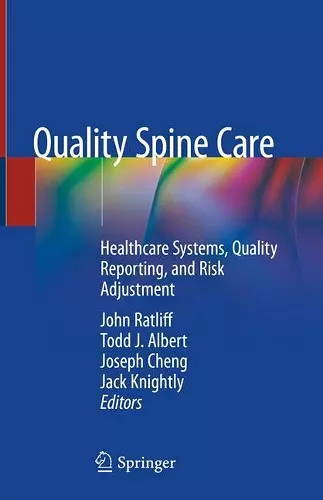Quality Spine Care
Healthcare Systems, Quality Reporting, and Risk Adjustment
Todd J Albert editor Joseph Cheng editor John Ratliff editor Jack Knightly editor
Format:Hardback
Publisher:Springer International Publishing AG
Published:7th Nov '18
Currently unavailable, our supplier has not provided us a restock date

Quality reporting is a rapidly growing area. Each year, new regulations in the US from the Council of Medicare and Medicaid Services make quality reporting a larger factor in determining reimbursement practices. Quality metrics are common parts of European clinical practice. Value of care is a focus of all payers, with specific interest directed at assessing the quality of care provided by a given healthcare team. While there are many publications in this space, no text has sought to provide an overview of quality in spine care.
Quality measurement and quality reporting are ever growing aspects of the healthcare environment. Quality assessment is valuable to all healthcare stakeholders: patients, physicians, facilities, and payers. Patients are drawn to facilities that provide high value care; public reporting systems and grading systems for hospitals offer one opinion with regard to “high quality care.” Most physicians email inboxes are inundated with offers of recognition for being a “Top Doc” for a nominal fee. Some payers offer incentives to patients who chose to be treated at “Centers of Excellence” or similar facilities; the definition of “Excellence” may be unclear.
There is little consensus on how to measure quality, how to incorporate patient and procedure factors and achieve accurate risk adjustment, and how to define value of care. Regardless of these challenges, regulatory efforts in the US, as well as numerous international efforts, make quality assessment and quality reporting an important part of physician behaviour.
Physician and facility reimbursement for procedures are often tied to quality metrics. Spine procedures are costly, elective, and are a focus of many payer-based programs. Hence, spine care is often a focus of quality reporting efforts. This text summarizes the state of the art with regard to quality measurement, reporting, and value assessment in spine care. We will review quality reporting in the US and internationally. Chapters will outline how quality improvement efforts have achieved success in hospital systems. The reader will be provided with insights in how to achieve success incorporating quality metrics into spine care.
Features:
1. Illustrates the state of the art in spine quality reporting: There is no text that thoroughly addresses quality assessment and quality reporting in spine care; there are, however, numerous articles in this space. ...
“The text appears intended for practicing neurosurgeons and orthopedic surgeons specializing in spine surgery, as well as clinical practitioners, hospital administrators, and other individuals directly involved in the care of patients with spinal disorders. … ‘Quality Spine Care: Healthcare Systems, Quality Reporting, and Risk Adjustment’ is very well written. Its concise chapters will aid any spine surgeon in optimizing one’s practice to focus on quality and value.” (Scott J. Raffa and Michael Y. Wang, Neurosurgery, Vol. 85 (4), October, 2019)
“The audience is practitioners, surgeons, public health specialists, and even healthcare administrators. The book meets the objective of addressing these audiences and is relatively straightforward in its explanations. … This is a high‐quality book that provides a great recapitulation of quality assessment in spine care. It is thefirst book its kind and is a great focused review of this topic.” (Ankit I Mehta, Doody's Book Reviews, July 05, 2019)
ISBN: 9783319979892
Dimensions: unknown
Weight: unknown
405 pages
2019 ed.